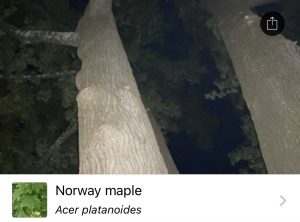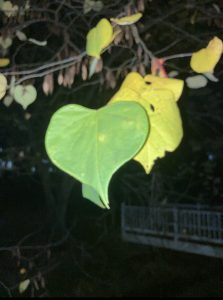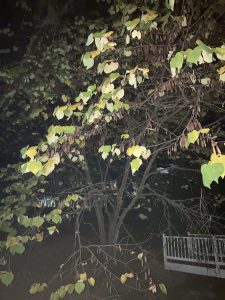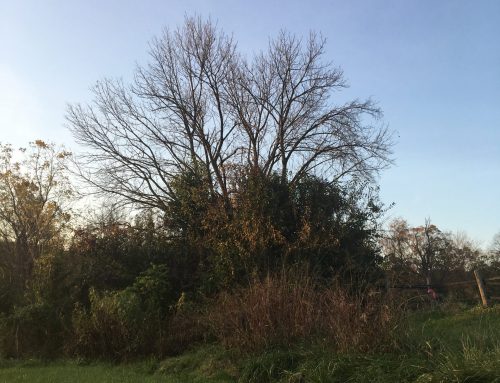I arrived at my sit spot at 7:45pm on 10/20/2020.
For this observation session, I decided to try something new and go to Beale Garden at night. Upon entering my sit spot, I was curious about what new observations I would make. In my previous sit spot blog posts, I described the sounds of cicadas and songbirds that filled the air around me with song; tonight, however, I heard a whole symphony. The ever-present cicadas were humming along as usual, but this time they were complemented by the sharp trill of crickets and an occasional solo from a confident frog. Other bugs and creatures chirped along with the music, their calls nearly indistinguishable from those of their peers. I breathed in the fall air, cool and crisp as it entered my lungs, closed my eyes, and enjoyed their performance.
I have synesthesia, which occurs when neurological pathways in the brain cross, causing the senses to blend with each other. In other words, I can “see” and “feel” sounds, “hear” textures, and so on. When it was time to tune in to what I could hear, I was excited to include that experience in my enjoyment of the nighttime symphony. I sat back and watched as crickets and cicadas drew thin ribbons of blue light across my vision, punctuated by the red-orange burst of snapping branches. In the distance, a train blew its whistle, and I thought of the train on the Polar Express as I saw an orange streak work its way across the bottom of my view. Once again I returned to my breath and the light scent of fall as I allowed the sight to envelop me in a feeling of calm.
I identified three species using the iNaturalist app: an Eastern Redbud, and a Norway Maple, and a Long-Stalked Sedge at the base of the maple tree. I had never heard of a Long-Stalked Sedge before, and was surprised at the strangeness of the name; I was even more surprised to find out that this grass-looking plant actually produces fruit in the spring and summer. I wonder if the fruit is edible for humans, and what the fruit tastes like. I also wonder if any animals make their habitat underneath the shelter of this plant. Next time I go to my sit spot, I will have to check and see what’s underneath that sedge.
 The Eastern Redbud was the tree with the ribbon
The Eastern Redbud was the tree with the ribbon  that I have been following. I enjoy its heart-shaped leaves. I also enjoyed learning that its flowers can be eaten fried or fresh, and that some people in Southern Appalachia use its green branches for seasoning. This tree produces winter buds, so I would be interested in finding out if those are used for anything.
that I have been following. I enjoy its heart-shaped leaves. I also enjoyed learning that its flowers can be eaten fried or fresh, and that some people in Southern Appalachia use its green branches for seasoning. This tree produces winter buds, so I would be interested in finding out if those are used for anything.
The Norway Maple is the tree under which I have been sitting for each of these observations. This tree is apparently an invasive species in North America, choking out local vegetation with its high germination rate and large seed crop. I wonder if this one is still dropping seeds; I will have to look for them during my next observation.
I left my sit spot at 8:45pm.
I very much enjoyed going to my sit spot at night. It was a very different experience than that of the daytime, and I once again appreciated the high levels of movement and life in a seemingly still place. I look forward to returning.




I switched my observation time too and noticed more birds around. Your description of the voices around you makes me want to go to Beale Garden! Enjoyed reading your blog, Marina!
Great blog Marina! I felt like I was actually in Beale Garden just by reading your post. I think you had a great idea to switch up the time you went to your sit spot. Amazing photos, once again!
I really want to go at night but I am so so scared, is it really different or was it the same?
That is awesome that you did a night sit spot – I love being outside at night! Nice detail!